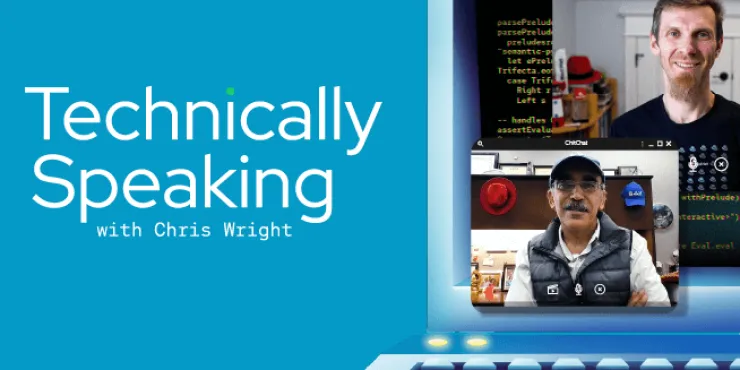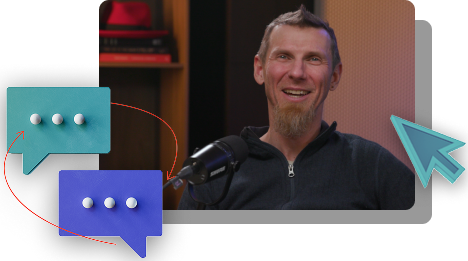
This video can't play due to privacy settings
To change your settings, select the "Cookie Preferences" link in the footer and opt in to "Advertising Cookies."
Lightspeed Automation with Generative AI
Is generative AI the future of IT automation? Explore AI-assisted code using Ansible Lightspeed with IBM watsonx Code Assistant. Join IBM Research Chief Scientist Ruchir Puri and Red Hat CTO Chris Wright to discuss how Ansible Lightspeed differs from other large language models like ChatGPT, and how Ansible community automation experts and the IBM and Red Hat collaboration on Project Wisdom created highly accurate and efficient foundation models that may help close IT skills gaps.
Transcript
Transcript
00:00 - Chris WrightThe current hype for generative AI is palpable. AI has been part of our daily lives for years, from search results to shopping recommendations to discovering new movies or curating your favorite new playlist. But the question of how pervasive AI tools will be for the rest of our lives remains to be seen, and that pervasiveness will be limited by their reliability. After all, what good is cutting-edge AI if it can't perform its intended function accurately? So how do we make AI more reliable and where is the balance between that wow factor and usability?
00:39 - INTRO ANIMATION
00:48 - Chris Wright
The power of language is undeniable. It enables us to communicate complex thoughts, emotions, and ideas with one another. As such, there is immense value in continuing to develop AI models that can accurately understand and interpret human language.
01:07 - Chris Wright
Natural language processing is a subfield of artificial intelligence that builds on computational linguistics. Computer programs perform tasks like tokenization, parts of speech tagging, semantic and sentiment analysis to understand, interpret, and generate human-readable language. Humans can figure out what a sentence or phrase is trying to say, even if the words or grammar aren't exactly correct.
02:30 - Dr. Ruchir Puri
Hey Chris. I'm doing well. Great to be with you here.
02:34 - Chris Wright
Yeah, thanks for chatting with me. I'm pretty interested, I mean the whole world's really excited about the potential of natural language processing, large language models. You've been working on this for quite some time and leveraging foundation models and generative AI in the project that we actually demonstrated in late 2022 together called Project Wisdom. And I know it's aimed at something a little different than maybe what most are familiar with when they think of generative AI and large language models. But I'm curious what's the motivation for you to start with Ansible as this content creation tool?
03:20 - Dr. Ruchir Puri
Our perspective into this is domain we specialize in, which is the domain world really cares about as well. Enterprises in particular is on information technology. And we focus on platforms. To scale things out, you need to have platforms that are scaled out as well. Obviously, if we look at sort of the broader portfolio of platforms in the world, Kubernetes, which is really incorporated as part of really our Red Hat OpenShift platform is one.
05:41 - Chris Wright
So when we take the work we started together in Project Wisdom and kind of bring it forward into really a commercial offering with Ansible Lightspeed powered by IBM's code assistant, your vision there is, well, let's help the world automate and we can sort of automate the automation. One of the things I think is interesting in this context is, well, when you work directly with the community, you were working with Ansible Playbook writers who are deep domain experts.
06:35 - Dr. Ruchir Puri
I would say Chris, to me, the most exciting part has been working with the community because the feedback you get is unfiltered. It's not filtered by any Kool-Aid, it is like a direct pipe actually. You get what you are going to feel actually. And I love it because that helps us improve. Honest feedback is more valuable than a very rosy feedback, I would say. And I think it has helped us improve tremendously. And for us, the Watson Code Assistant was trained with the trusted content that from the Ansible, really domain that is governed, that is, we stand behind it, we as a Red Hat team, stand behind it as well. And it brings the power of certain language, in this case YAML within the context of Ansible to the Watson Code Assistant to make it ... no, I said it in many other talks as well.
08:01 - Chris Wright
Definitely, a convincingly crafted piece of YAML that does absolutely nothing useful is a waste of everybody's time, which you do see sometimes with large language models, the general purpose ones. So having this specificity, accuracy, trusted content that you're using to train the model with seems really, really important. What about being able to recognize outputs from inputs, do you have a way to do any kind of attribution or connecting what you trained to what you're putting out?
08:40 - Dr. Ruchir Puri
Because this is such an important point because something that has been sort of really ... I would say has been on a lot of people's mind is people who have generated this content, who are the experts at it, whether they were visual artists or whether they were journalists or whether they were developers, that content is out there, it becomes not just a ethical and a responsible thing to do, which should always come first, but also a sort of a efficient thing to do as well.
09:49 - Chris Wright
The way you're describing it, I'm really starting to picture a team of collection of humans and some virtual team members, a code assistant, a couple code assistants. And when we combine the focus initially on Ansible expanding to other languages, the abilities to do discovery, you can really see how the future of development is going to be complimented by, powered by, supported by AI and machine learning models. For sure this has been a great conversation. Thank you so much.
10:26 - Dr. Ruchir Puri
Oh, thank you, Chris, for having me. I think we are on a wonderful journey together and looking forward to benefiting the community and community benefiting the enterprises as well. Thank you.
10:38 - Chris Wright
As our next wave of generative AI tools look to simplify the path to information technology, they can't replace the critical thinking and creativity that humans bring to the table. The community's expertise and impact in developing and evolving the models and their direct feedback and support is essential for success. And as adoption grows, so will quality and broader usability. Ansible Automation is just the starting point and what we learn here will shape the future of machine-augmented human intelligence.
About the show
Technically Speaking
What’s next for enterprise IT? No one has all the answers—But CTO Chris Wright knows the tech experts and industry leaders who are working on them.
